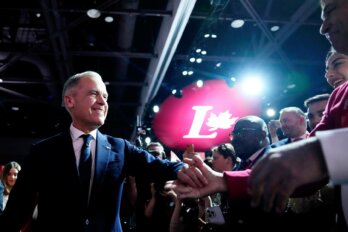It’s not hard to imagine a stadium filled with tens of thousands of young people cheering wildly. But, before 2015, it would have been difficult to imagine them cheering for anything other than a pop star or sports team, let alone a dishevelled seventy-four-year old man ranting about campaign-finance reform.
Yet that’s exactly what happened when Bernie Sanders crossed America like a rock star, waving his hands in the air while declaring, “We need to get big money out of politics and restore our democracy to combat a corrupted political system controlled by deep-pocketed special interests and the billionaire class.”
Sanders was tapping into a fear held by citizens across the Western world: that our elections barely matter anymore because a handful of very wealthy people behind the scenes have much more influence than we do. This sense of political hijacking feeds our growing cynicism towards politics in general, and Sanders figured out how to turn that cynicism into both anger and hope, mobilizing passionate citizens from coast to coast.
Here in Canada, corporate influence on democracy is as old as our political system itself. Our very first prime minister, Sir John A. Macdonald, resigned in disgrace after newspapers revealed that he’d not only accepted a bribe but actively pursued it. A political “donation” of $360,000 had apparently been made in exchange for a promised multi-million-dollar contract to build Canada’s first transcontinental railroad. The public backlash was swift, leading not only to Macdonald’s resignation but to the collapse of his Conservative government.
Bribery is still a part of Canadian politics today, at all three levels of government. (To learn more, google any of these phrases: MFP scandal, Airbus affair, Charbonneau Commission, or Gomery report.) But stories of politicians or political staffers explicitly breaking rules for their own self-interest represent only the tip of the iceberg and are arguably a distraction from the bigger picture. The primary problem we’re facing isn’t criminal activity but rather the fact that excessive private influence has become a normal and legal part of our system. To put it more bluntly, our political system has evolved into a sophisticated enabler of institutionalized mass, bribery. In just the past couple of years, for example, we saw an enormous public outcry against “cash for access” fundraisers, where wealthy donors schmooze with ministers and parliamentarians in exchange for a hefty fee. The parties of Justin Trudeau, former Ontario premier Kathleen Wynne, and former BC premier Christie Clark in particular were publicly shamed, and each was pressured to introduce legislation designed to limit or minimize these kinds of exchanges. You’d think that 150 years after Macdonald’s Pacific Scandal, we’d have this figured out.
Instead, we seem to be going in circles in a kind of a political Groundhog Day. Despite decades of promises and reforms, powerful corporations continue to wield enormous power in our legislatures and our city halls. So why is it so hard to get big money out of politics? The best analogy I’ve heard to describe the problem is that water always finds a way. In other words, you can build a dam, but eventually the water will flow over it or find another route around it. Money, too, has an uncanny way of finding its destination.
Some jurisdictions in Canada have implemented regulations that attempt to restrict the flow of political donations. You can think of a valve that limits how much water gets through. The valve can be turned off completely by placing an absolute ban on certain types of contributions. In 2004, for instance, Prime Minister Jean Chrétien’s Liberal government banned all corporate donations, shutting one valve. But just because a company can’t donate directly, that doesn’t mean its CEO, directors, or lobbyists can’t donate personally, as citizens, achieving the same result. That led us to the cash-for-access problem, where company representatives were paying money to get face-to-face meetings with cabinet members.
Similarly, Toronto city council banned corporate donations in 2009, but according to a 2016 Toronto Star investigation, some of the donations that used to come directly from companies now simply flow through alternative (and less transparent) channels, including via family members. Porter Airlines, for example, used to contribute money to municipal candidates using corporate cheques. After the ban, the Star investigation found that $11,100 was donated to city hall candidates by Porter president and CEO Robert Deluce, along with his wife, daughter, and son—all using personal cheques.
In 2006, Liberal leadership candidate Joe Volpe received $108,000 from family members connected to executives of Apotex Pharmaceuticals. He later returned $27,000 that was shown to have come from children under the age of eighteen, including a fourteen-year-old and two eleven-year-old twins (each of whom donated $5,400, the maximum allowed). Water finds a way.
If there was one single pipe connecting companies to politicians, we could simply turn it off with one twist of the valve. But, as we’ve seen, water can simply flow through another pipe. And there are lots of pipes—a messy labyrinth with multiple routes connecting each source and destination. From a private company, water can travel through board directors, family members, employees, or professional lobbyists. It can also flow through third parties, such as industry associations or political-action committees. And the water often doesn’t flow directly to politicians but travels through political parties, riding associations, nomination races, or leadership campaigns. When we connect all these detours, we end up with dozens of possible ways for water to reach its goal.
Because there are so many routes for the water to travel, you can see how hard it is to try to control the flow of corporate money into our political system with valves alone. That’s why many campaign-finance reforms often focus not on how much money is flowing but on the transparency of the flow. Disclosure regulations force candidates to publicly share detailed information about how much water they have and which pipes it came through. Remember the cash-for-access scandals? Of the three parties involved, only one (the Ontario Liberals) agreed to ban these shady gatherings and completely close that particular valve. The other two parties (the federal Liberals and the BC Liberals) simply added new rules to increase disclosure and transparency. Essentially, they said, “We’re still going to sell access to politicians, but we’ll put a water meter on it.”
Disclosure can be helpful, but it depends on the details of the regulations and what people do with that information afterwards. The City of Toronto, for example, has disclosure rules that force all candidates to reveal the names of their campaign donors. But the information isn’t made available until after the election, which renders it quite useless in terms of helping voters make an informed decision. And, unlike some disclosure systems that require donors to reveal their occupation, employer, and board appointments, the Toronto program (and most in Canada) requires only a name and address. That makes it difficult to track the funds back to a source.
So we need more information, but we also need an overhaul of how that information is presented. Disclosure records are enormous, and the onus is currently on voters to decipher them. A mayoral election in Toronto might have as many as 5,000 donors, so you can imagine how hard it would be to go through all that data and try to figure out which companies were attempting to influence which candidates. The City also collects enormous amounts of detailed information about which lobbyists speak to which politicians about which subjects. But both of these data sets are provided in a hard-to-search PDF format, so that no one really looks at them—and, more importantly, no one is connecting the dots between them.
Some information can have value on its own, but other kinds have meaning only when cross-referenced with another data set. You know those nutritional charts on packaged food? Those lists consist of three separate pieces of data: the number of nutrients/calories in the package, the recommended daily intake for each, and the serving size. That’s all good data to have, but what makes it really effective and practical is that Health Canada forces food manufacturers to include all three pieces on one simple label. Imagine if you wanted to buy a box of cereal and had to check three websites to find out the nutritional value. One website tells you how much iron is in the whole box, another tells you how much iron you need each day, and a third tells you how many bowls of cereal are in each box. Prediction: no one would look at any of the websites, and it would be as if the data didn’t exist. And that’s exactly how Toronto’s current lobbyist registry and campaign disclosure records work.
Why aren’t we already doing this kind of cross-referencing of lobbyist records and campaign-donor data automatically? The first step would be to make sure that disclosure records are being released as a proper digital data set rather as a PDF. That way, anyone could access the information through an open-data portal and create their own charts, lists, analyses, and so on. Even better, government IT staff could write some software code that would automatically correlate every single donation to the existing lobbyist records. This would be an incredible resource for voters and journalists during an election, but it could also be used between elections. Just before each vote in Parliament or at a city council, a list would be published online showing not only which politicians were lobbied on that topic but how much money they accepted from those lobbyists or other people associated with their client (including family members).
Coincidentally, Toronto’s lobbyist registry and Canada’s mandatory-food-labelling legislation were both introduced in the same year–2007–but only one requires the data to be cross-referenced to give it context. So, essentially, we have all this amazing disclosure information about big money in politics, but it mostly goes unnoticed. No one is reading the water meters.
The most important fix doesn’t involve valves or meters. Election campaigns are expensive, and that money has to come from somewhere. Campaigns need fuel—fuel for advertising, printing, polling, office rent, and staff salaries. Rich folks have fuel. Large companies have fuel. We’ll never be able to eliminate their desire to influence the political process, but we can displace the need for political donations in the first place by filling the pipes with clean fuel.
Injecting clean, tax-funded fuel into election campaigns shouldn’t be controversial. We already publicly fund almost every aspect of elections anyway: the printing of ballots, hiring of election staff, purchasing of tabulation machines, renting of voting stations, and so on. Every single part of our elections is funded by you and me—except for the most important part: the actual campaigns! The best model I’ve seen for clean campaign fuel is a bold experiment taking place in Seattle: coupons called Democracy Dollars. Four coupons, each worth $25 of public money, are mailed to every voter to give to the candidate(s) of their choice. This system puts complete control of the public subsidy into the hands of all voters, on a level playing field. It’s the only system that allows all voters, regardless of disposable income, to participate equally in an election campaign. It provides candidates with a unique incentive to knock on doors and talk to voters. Rather than perpetuating the inertia of the status quo, these dollars can work to amplify new and emerging voices.
In 2017, Seattle’s first time trying this new system, the number of campaign donors tripled and reached an all-time high. An estimated 84 percent of the donors were new to the political process, and donors were much more reflective of the general population (with more donations coming from youth, women, people of colour, and low-income residents). The previous election was dominated by big money, and less than 50 percent of total donations came from small contributions. But in 2017, that number had jumped to 87 percent.
Here’s the bottom line: we’ll never have a trustworthy, reflective, or responsive democracy if we aren’t prepared to take a deeper look at how campaigns are fuelled. Valves and meters are crucial mechanisms that can help us track and reduce the influence of private wealth on our elections. Without bold reforms, we’ll continue shutting some valves while others burst open, perpetuating the political Groundhog Day that has seen private interests dominate our political culture for 150 years.
Adapted from Teardown: Rebuilding Democracy from the Ground Up by Dave Meslin. Copyright 2019 Dave Meslin. Published by Penguin Canada, a division of Penguin Random House Canada Limited. Reproduced by arrangement with the Publisher. All rights reserved.





